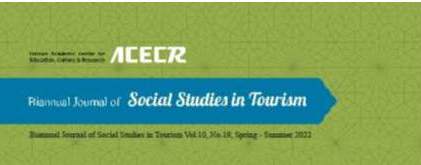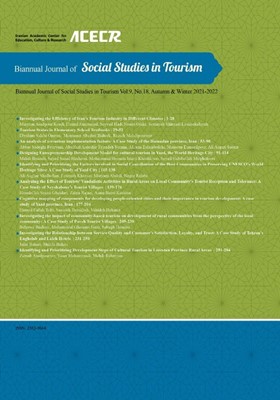-
-
List of Articles
-
Open Access Article
1 - Investigating the Efficiency of Iran's Tourism Industry in Different Climates
maryam asadpour kordi hamid amirnejad seyed hadi naseri ojaki somayeh shirzadi laskukalayeh -
Open Access Article
2 - Tourism Status in Elementary School Textbooks
ebrahim salehi omran memanat Abadini bltark -
Open Access Article
3 - An analysis of e-tourism implementation factors: A Case Study of the Hamadan province, Iran
Abbas Sadeghi Pouryani Abolfazl Tajzadehnamin alireza slambolchi Mansour Esmaeilpour Ali Asgari Sarem -
Open Access Article
4 - Designing Entrepreneurship Development Model for cultural tourism in Yazd, the World Heritage City
Mehdi Basouli seyed saeed hashemi Mohammad Hossein Imani khoshkho Seysd habib o allah mirghafouri -
Open Access Article
5 - Identifying and Prioritizing the Factors involved in Social Contribution of the Host Communities in Preserving UNESCO's World Heritage Sites: A Case Study of Yazd City
Ali Asghar Shalbafian Fatemeh Khazaei Maryam Abdoli Negar Rajabi -
Open Access Article
6 - Analyzing the Effect of Tourists’ Vandalistic Activities in Rural Areas on Local Community’s Tourist Reception and Tolerance: A Case Study of Neyshabour’s Tourist Villages
Hamdollah Sojasi Qeidari zahra rajaei Asma Bazri Keshtan -
Open Access Article
7 - " Cognitive mapping of components for developing people-oriented cities and their importance in tourism development: A case study of Yazd province, Iran "
Hamed Fallah Tafti saeede derakhsh vahideh hekmat -
Open Access Article
8 - Investigating the impact of community-based tourism on development of rural communities from the perspective of the local community: A Case Study of Paveh Tourist Villages
behrooz badko -
Open Access Article
9 - Investigating the Relationship between Service Quality and Customer's Satisfaction, Loyalty, and Trust: A Case Study of Tehran's Enghelab and Laleh Hotels
jafar bahari Shahla Bahari -
Open Access Article
10 - Identifying and Prioritizing Development Steps of Cultural Tourism in Lorestan Province Rural Areas
zeinab asadporiyan yaser mohamadi mehdi rahimian
-
The rights to this website are owned by the Raimag Press Management System.
Copyright © 2017-2025







